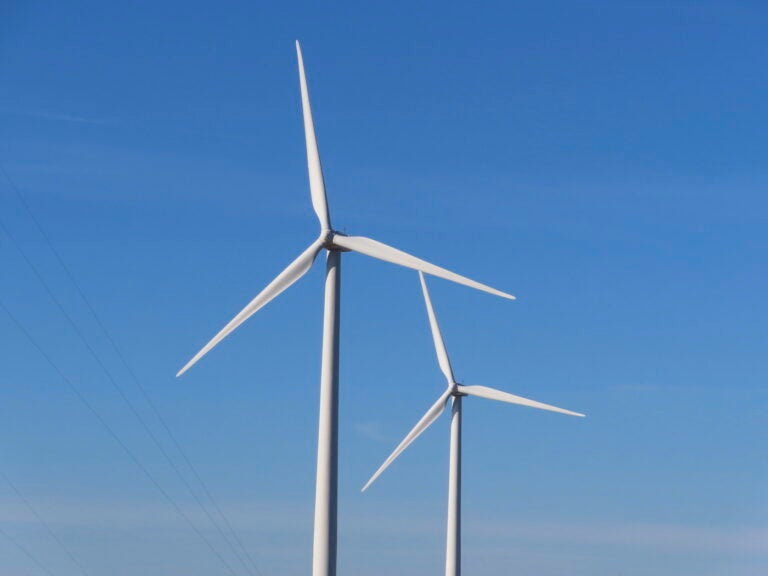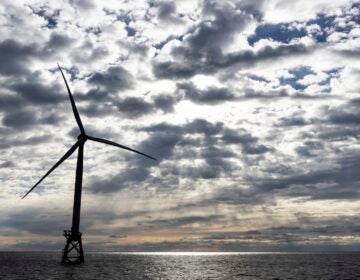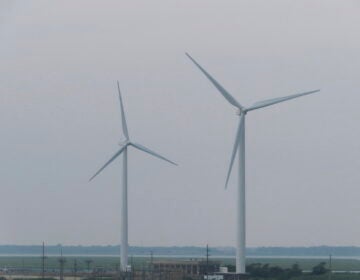New Jersey takes an ‘educated leap into the future’ as state approves 2 new offshore wind projects
The newly approved offshore wind farms will be located about 40 miles off the N.J. coast and generate enough electricity to power 1.8 million homes.
Listen 1:36
Land-based wind turbines spin in Atlantic City N.J. on Nov. 3, 2023. New Jersey approved two massive offshore wind projects on Jan. 24, 2024. (AP Photo/Wayne Parry)
This story is part of the WHYY News Climate Desk, bringing you news and solutions for our changing region.
From the Poconos to the Jersey Shore to the mouth of the Delaware Bay, what do you want to know about climate change? What would you like us to cover? Get in touch.
New Jersey approved two massive offshore wind projects Wednesday, expected to power up to 1.8 million homes, create 27,000 new jobs and inject more than $3 billion into the state’s economy. The unanimous decision by the state’s Board of Public Utilities comes on the heels of a major setback back in October after Danish wind giant, Orsted, announced it would cancel its projects in New Jersey, citing inflation, rising interest rates and supply chain issues.
Together, the newly approved projects will generate 3,742 megawatts of electricity, helping to slash the state’s carbon emissions by one-third and reach Governor Phil Murphy’s goal of 100% clean energy by 2035.
“Today’s actions are about the future and the contributions we make to our children and grandchildren,” said BPU Commissioner Zenon Christodoulou. “The cost of inaction is incalculable. The benefits are real. Proper investment and innovation have always served mankind, improved lives and allowed us to chart a course into the unknown.”
The winning proposals include Invenergy Energy’s Leading Light Wind, a 2,400-megawatt project about 47 miles off the coast of Atlantic City. It is expected to be completed in two phases by 2031 and 2032. Invenergy is the first U.S. company awarded a contract to build a utility scale offshore wind project.
Attentive Energy, a joint venture of the French company Total Energy and Corio Generation, will build a 1,342-megawatt project about 42 miles off the coast of Seaside Heights.
Both deals include funds to mitigate environmental impacts and agreements to purchase equipment from the Paulsboro windport, which had originally been dependent on Orsted as a customer. The German company, EEW, one of the largest manufacturers of monopiles, which serve as the foundations for turbines, will now be the supplier to both projects.
Orsted’s decision to pull out of New Jersey last October angered Gov. Murphy, who pledged to make the state the offshore wind hub for the entire East Coast, which the BPU says is now back on track.
“Depending on unreliable global energy suppliers to fuel our vehicles, to power our businesses, and to warm homes around the world, is a failure of foreign policy that has affected generations,” Christopoulou said. “We can’t kick the can down the road any longer. We have a chance to reverse that course and New Jersey will lead the way once again.”
The guaranteed price that the companies will fetch from electricity suppliers in the state is higher than what Orsted had negotiated, but in line with current fossil fuel prices. Invenergy agreed to collect $112.50 per MW hour for the first year. In addition to shoring up the Paulsboro wind port, the company also agreed to spend $94 million to help reduce electricity costs for low-income households. Attentive Energy will garner $131 per MW hour in the first year.
Critics of offshore wind have pointed to the potential impact on fisheries and tourism, as well as rising rates that will benefit company shareholders and leave ratepayers saddled with the higher costs of clean energy. Links to whale deaths have been debunked by scientists. The New Jersey Division of Rate Counsel has warned of the impacts on consumers.
Although it’s unclear how much of these costs will be passed on to consumers, and how much will be mitigated by federal subsidies, Commissioner Christodoulou promised protection for ratepayers and no further hand-outs should the companies fail to make due on their promises.
“We are at the leading edge of the clean energy revolution,” he said. “Prices are dropping, quality is improving, acceptance is expanding, and economies of scale, mass production, standardization and learning curves are all aligning.”
He said “business as usual” fossil fuel-generated power is not an option now that climate change has arrived.
“But the contracts we are awarding are tight and hold the awardees accountable to our production schedules and pricing schemes,” he said. “We will enforce those guarantees with relentless oversight and unwavering defense of our ratepayers. There will be no hat-in-hand requests, no unforeseen expenses, no nickel and diming. The New Jersey ratepayers and all of us are taking an educated leap into the future. But that leap must come with the appreciation that the die is cast and we cast it high.”
Referencing Julius Caesar crossing the Rubicon, Christodoulou emphasized ratepayers would not be on the hook for the wind industry’s stumbles.
“If they need one more proverbial centurion, one more horse, one more shield or one more sword, New Jersey ratepayers will not pay for it,” he said.
The two companies will also contribute a combined $39 million for environmental research and monitoring.
“That’s great news,” said Kris Ohleth, executive director of the Special Initiative for Offshore Wind, an independent think tank that supports offshore wind development.
Ohleth, who has worked in the industry for several decades, including a stint with Orsted, said Wednesday’s contracts with Invenergy and Attentive appear more robust than the deals cut previously. She said pre-pandemic, wind companies like Orsted could not have predicted the inflation and supply chain issues that made it unaffordable to build at the rates it agreed to get from the electricity providers.
“The BPU staff and commissioners are going to pay a lot more attention to the milestones [after] learning lessons from the past,” Ohleth said, adding that she wouldn’t be surprised to see others pull out like Orsted. Before Wednesday’s decision, Atlantic Shores had been the only remaining viable project off the coast of New Jersey. It includes the development of 1,510 megawatts off Barnegat Light. Atlantic Shores had made an additional proposal in this round to the BPU but wasn’t chosen.
“If they’re looking to spread the risk for this important resource development, [it makes sense] that [the BPU] didn’t make an award to Atlantic Shores,” Ohleth said.

Get daily updates from WHYY News!
WHYY is your source for fact-based, in-depth journalism and information. As a nonprofit organization, we rely on financial support from readers like you. Please give today.







